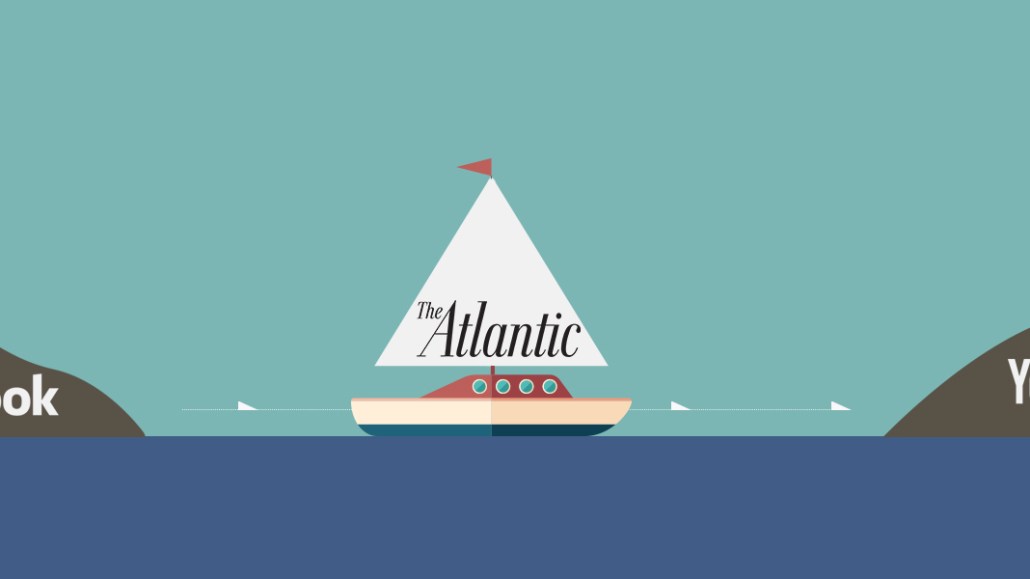Save 50% on a 3-month Digiday+ membership. Ends Dec 5.
‘Focused on profitability’: Why The Atlantic is shifting its focus to YouTube

Forget food videos on the feed: The Atlantic is sailing against the winds, opting for longer videos as part of series that are distributed through YouTube.
The 160-year-old publication, which has a small video operation compared to the distributed-media publishers that get billions of monthly views on Facebook, is focusing on creating longer videos that dive into serious topics such as science and politics. This includes weekly video series featuring its lineup of star editors and reporters, as well as animated videos and documentary features. At the same time, The Atlantic is prioritizing YouTube as the platform to distribute this content. The reason: Not only is YouTube the place where this type of content performs best, but YouTube is still the best place for publishers — especially smaller ones with a limited amount of resources — to reach a lot of viewers while also generating consistent revenue from pre-rolls. (YouTube typically takes a 45 percent cut of ad revenue from pre-rolls.)
“We tend to be pretty focused on profitability — new investments require that revenue comes along with them,” said Kim Lau, vp and gm at The Atlantic. “The big shift for us is the realization over time that while our audience at TheAtlantic.com is interested in and increasingly aware of our video, being able to grow [our video business] with just that audience is a little bit of a limitation.”
With a billion daily users on YouTube and countless videos to watch, YouTube certainly offers a reach that few others can match. It also offers a lot of noise.
The Atlantic’s approach to standing out is focusing on distinctive content that works well on YouTube’s platform, rather than pushing out as many videos as possible. Today, it’s launching a new science video series called “You Are Here,” which will feature The Atlantic’s science, health and technology writers exploring topics such as why Americans smile so much, the science of cool and whether social media is changing friendships. “You Are Here” joins other weekly video series such as “The Atlantic Argument,” a commentary series covering the latest news and political issues, and “Unpresidented,” which explores the new American political landscape. These shows follow a weekly release schedule.
“We know YouTube rewards consistency,” said Kasia Cieplak-Mayr von Baldegg, gm and executive producer for Atlantic Studios, “but we also try to jump on the news cycle, especially with ‘The Atlantic Argument,’ when there is something of huge interest for our audience.”
The Atlantic is also focusing on animation and explainer videos. These can be a combination of animations placed within existing editorial video series as well as animated interviews with interesting guests like Bill Nye. Both formats have performed well on YouTube; CNN’s Great Big Story, for instance, has an entire team devoted to animations, while Vox has grown a substantial YouTube following by focusing on in-depth (longer) explainer videos that frequently feature animation.
Ad position: web_incontent_pos1
While these shows aim to bring more regular viewers — and subscribers — back to The Atlantic’s YouTube channel, they are also in the service of a handful of longer documentaries The Atlantic puts out every month. The publisher typically releases two or three documentary features, typically running for 10 minutes or longer, every month. These go in-depth on topics ranging from Nazi Richard Spencer to American towns that welcome refugees.
With this approach, people are beginning to come to The Atlantic’s YouTube channel and spend time watching videos. The average watch time among The Atlantic’s 41,000 subscribers was more than three minutes last month, the publisher said.
“Among the distributed video platforms, YouTube is so strong at creating an experience where people are watching longer videos and with the sound on,” said Cieplak-Mayr von Baldegg.
Of course, many scale-seeking digital publishers are still prioritizing Facebook because that still remains the best place to grab a lot of views in a short period of time. The Atlantic, like other publishers, is not ignoring Facebook. But it’s honest about Facebook’s limitations right now. The Atlantic will cut shorter versions of its videos — and include captions — for Facebook.
“Focusing on YouTube now allows us to bring monetization and high-quality storytelling all together in one place,” said Lau. “We’ll continue to dabble on Facebook.”
More in Media

What publishers are wishing for this holiday season: End AI scraping and determine AI-powered audience value
Publishers want a fair, structured, regulated AI environment and they also want to define what the next decade of audience metrics looks like.

Digiday+ Research Subscription Index 2025: Subscription strategies from Bloomberg, The New York Times, Vox and others
Digiday’s third annual Subscription Index examines and measures publishers’ subscription strategies to identify common approaches and key tactics among Bloomberg, The New York Times, Vox and others.

From lawsuits to lobbying: How publishers are fighting AI
We may be closing out 2025, but publishers aren’t retreating from the battle of AI search — some are escalating it, and they expect the fight to stretch deep into 2026.
Ad position: web_bfu




